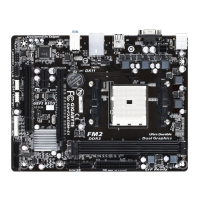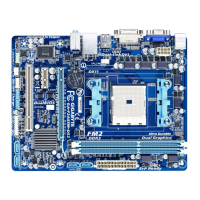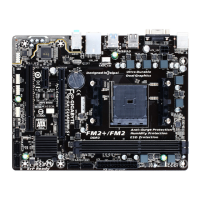- 32 -
Chapter 3 Appendix
Beforeyoubegin,pleasepreparethefollowingitems:
• At least two SATA hard drives (to ensure optimal performance, it is recommended that you use two hard drives
with identical model and capacity). If you do not want to create RAID, you may prepare only one hard drive.
• Windows setup disk.
• Motherboard driver disk.
• A USB ash drive.
ConguringtheOnboardSATAController
A.InstallingSATAharddrive(s)inyourcomputer
Attach one end of the SATA signal cable to the rear of the SATA hard drive and the other end to available SATA
port on the motherboard. Then connect the power connector from your power supply to the hard drive.
B.ConguringSATAcontrollermodeinBIOSSetup
Make sure to congure the SATA controller mode correctly in system BIOS Setup. For the BIOS Setup menus,
refer to Chapter 2, "BIOS Setup," "Integrated Peripherals."
Steps:
1. Turn on your computer and press <Delete> to enter BIOS Setup during the POST (Power-On Self-Test).
Ensure OnChipSATAChannel is enabled under Peripherals\SATAConguration. To enable RAID for
the SATA3 0/1/2/3 connectors, set OnChipSATAType to RAID. To enable RAID for the SATA3 4/SATA3
5 connectors, set OnChipSATAType to RAID and set OnChipSATAPort4/5Type to As SATA Type.
2. If you want to congure UEFI RAID, follow the steps in "C-1." To enter the legacy RAID ROM, save the
settings and exit BIOS Setup. Refer to "C-2" for more information.
3-1 ConguringaRAIDSet
The BIOS Setup menus described in this section may differ from the exact settings for your motherboard.
The actual BIOS Setup menu options you will see shall depend on the motherboard you have and
the BIOS version.
C-1.UEFIRAIDConguration
Only Windows 8.1/8 64-bit supports UEFI RAID conguration.
To congure UEFI RAID, you need to prepare a USB ash drive using FAT 32 le format and copy all les
(including the UEFI RAID utility rcadm.e) in the \BootDrv\UEFI RAID Utility folder in your motherboard driver
disk to the ash drive. Then follow the steps below.
Steps:
In BIOS Setup, go to BIOSFeatures and set Windows 8 Features to Windows 8 and CSM Support to Never.
Save the changes and exit BIOS Setup.
Running the UEFI RAID Utility
Restart your computer and press <F12> to enter the boot device conguration menu. Use the up or down arrow
key to select your USB ash drive which is prexed with "UEFI:" string. Then press <Enter> to access the screen
as shown in Figure 3. To run the UEFI RAID utility, enter the following commands.
RAID Levels
RAID 0 RAID 1 RAID 10
Minimum
Number of Hard
Drives
≥2 2 4
Array Capacity
Number of hard
drives * Size of the
smallest drive
Size of the smallest
drive
(Number of hard
drives/2) * Size of the
smallest drive
Fault Tolerance No Yes Yes

